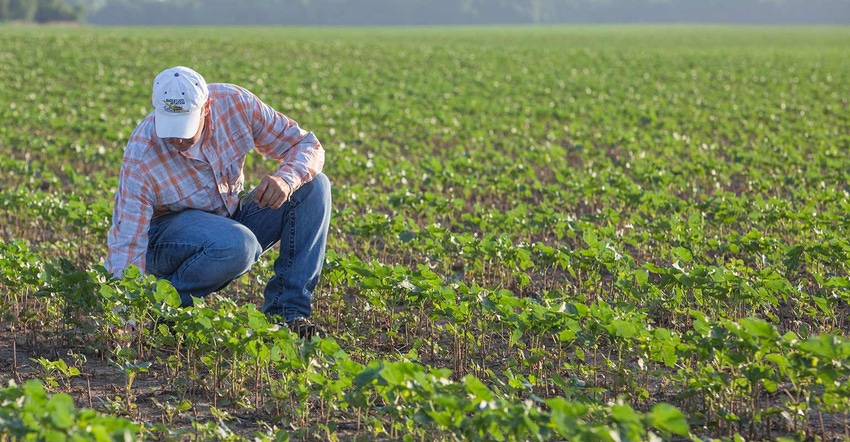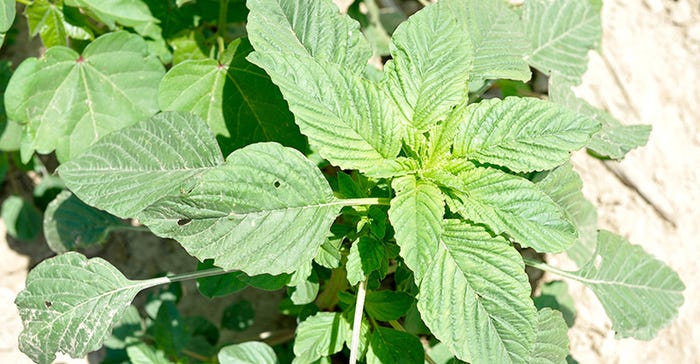March 1, 2022

Sponsored Content
Known for its long emergence, rapid growth, prolific seed production and ability to develop resistance to herbicides, Palmer amaranth can be a farmer’s worst enemy.
Until about a decade ago, Palmer amaranth was relatively unheard of in the Midwest. Since then, this pigweed has made a name for itself as one of the most competitive weeds in corn, soybean and cotton fields across the country.
Knowing how devastating Palmer amaranth can be, it’s important that farmers learn how to identify and manage the weed.
Identifying Palmer Amaranth

Scouting fields to determine which weeds are most prevalent is a key step in developing any successful weed management program.
However, since Palmer amaranth, redroot pigweed and waterhemp all fall into the pigweed category, telling Palmer amaranth apart from its cousins can be a challenge.
Here are characteristics that can help you identify Palmer amaranth:
The leaves tend to be wider and ovate to diamond-shaped.
The stems are smooth and hairless.
The petioles will be as long or longer than the leaf blades themselves.
The terminal seed heads on female Palmer amaranth plants can grow up to 3 feet long and will feel prickly.
Some leaves have a white, chevron-shaped watermark.
Control Requires a Multipronged Approach
A proactive and strategic management plan is necessary to combat Palmer amaranth in your fields.
This means implementing a weed control program that uses multiple sites of action:
Start with a burndown and/or tillage. “Start clean, stay clean” remains the best tactic for season-long weed control.
Adopt preemergence residuals that offer multiple sites of action. This practice not only helps keep fields cleaner during the growing season but also helps limit the development of resistant weeds.
Spray postemergence when weeds are small: 3 inches tall or less.
Use a postemergence treatment that’s proven to knock out Palmer amaranth — such as Enlist One® herbicide tank-mixed with Liberty® herbicide.
Enlist E3® soybeans and Enlist® cotton are tolerant to 2,4-D choline in Enlist herbicides and to glufosinate, the active ingredient in Liberty herbicide. With a tank mix of Enlist One and Liberty herbicides or sequential applications of Enlist Duo® and Liberty herbicides, you get effective postemergence control on tough broadleaves like waterhemp and Palmer amaranth, plus broad-spectrum control of a host of other weed species.
In fact, a recent Corteva Agriscience trial, conducted across seven locations, demonstrated a tank mix of Enlist One and Liberty herbicides provided 91% control of Palmer amaranth.1
For more information on how this tank mix can help you kill adaptable and invasive weeds like Palmer amaranth, talk with a local Corteva Agriscience or BASF representative and view this fact sheet.
1 Control of 3- to 4-inch Palmer amaranth in 2020 Corteva Agriscience trials with Enlist One® herbicide at 32 fl oz/A, Liberty® herbicide at 32 fl. oz/A., glyphosate DMA at 29 fl. oz/A. and AMS at 2.5 v/v
™ ® Enlist, Enlist Duo, Enlist E3 and Enlist One are trademarks of Corteva Agriscience and its affiliated companies. ® Liberty is a registered trademark of BASF. The transgenic soybean event in Enlist E3® soybeans is jointly developed and owned by Corteva Agriscience and MS Technologies, L.L.C. Enlist Duo® and Enlist One® herbicides are not registered for sale or use in all states or counties. Contact your state pesticide regulatory agency to determine if a product is registered for sale or use in your area. Enlist Duo and Enlist One herbicides are the only 2,4-D products authorized for use with Enlist crops. Consult Enlist herbicide labels for weed species controlled. Always read and follow label directions. © 2022 Corteva
About the Author(s)
You May Also Like






